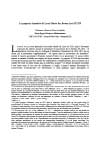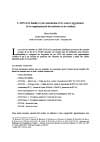Marc Gabolde
« Le papyrus-Amulette de Lyon MusĂ©e des Beaux-Arts H 2425 »
ENiM 6, 2013, p. 159-168.
 Édition du papyrus de Lyon Musée des Beaux-Arts H 2425, document datant de l’époque ptolémaïque rédigé en hiératique avec la formule 100 du Livre des morts accompagnée de son illustration. L’étude de ce manuscrit donne l’occasion de revenir sur la fonction et l’utilisation de cette catégorie d’objets en contexte funéraire.
Édition du papyrus de Lyon Musée des Beaux-Arts H 2425, document datant de l’époque ptolémaïque rédigé en hiératique avec la formule 100 du Livre des morts accompagnée de son illustration. L’étude de ce manuscrit donne l’occasion de revenir sur la fonction et l’utilisation de cette catégorie d’objets en contexte funéraire.
 Edition of the papyrus Lyon Musée des Beaux-Arts H 2425, which can be dated to the Ptolemaic period. It is written in hieratic and contains the Spell 100 of the Book of the Dead with her illustration. The study of this manuscript allows us to reconsider the function and use of this category of objects in funerary context.
Edition of the papyrus Lyon Musée des Beaux-Arts H 2425, which can be dated to the Ptolemaic period. It is written in hieratic and contains the Spell 100 of the Book of the Dead with her illustration. The study of this manuscript allows us to reconsider the function and use of this category of objects in funerary context.
 Consulter cet article (52385) -
Consulter cet article (52385) -  Télécharger cet article au format pdf (27917)
Télécharger cet article au format pdf (27917)
« L’ADN de la famille royale amarnienne et les sources Ă©gyptiennes. De la complĂ©mentaritĂ© des mĂ©thodes et des rĂ©sultats »
ENiM 6, 2013, p. 177-203.
 Les enquêtes menées sur l’ADN des momies royales publiées en 2010 ont fourni des matériaux pour un nouvel arbre généalogique de la famille royales de la fin de la XVIIIe dynastie. Après avoir discuté de la fiabilité de ces études, un examen approfondi des résultats conduit à la conclusion que certains liens de parenté révélés par l’ADN ont échappé à l’équipe de généticiens. Le plus significatif de ceux-ci consiste dans le fait que Youya partage avec son gendre Amenhotep III environ 1/3 de son patrimoine génétique. Il est proposé, en conséquence, que Youya ait été un oncle d’Amenhotep III, ce qui signifie que Tiyi était une cousine germaine de son mari. En extrapolant pour la génération suivante, on suggère qu’Amenhotep IV – Akhenaton a également épousée sa propre cousine, Nefertiti, dont les parents étaient liées à la fois à Youya et Amenhotep III. Ceci expliquerait pourquoi l’ADN d’Amenhotep IV – Akhenaton (momie de KV 55) et celui de Nefertiti, identifiée, à la Young Lady de la tombe d’Amenhotep II (KV35YL) aient pu sembler ceux d’un frère et d’une sœur. En accord avec les témoignages écrits de nouveau examinés en détail, Toutankhamon est considéré comme le septième et dernier enfant d’Amenhotep IV – Akhenaton et Nefertiti et, de son côté, la momie KV21A est donnée comme vraisemblablement celle de Moutemouiya. Un nouvel arbre généalogique, fondé sur ces données ADN et épigraphiques est proposé en conclusion.
Les enquêtes menées sur l’ADN des momies royales publiées en 2010 ont fourni des matériaux pour un nouvel arbre généalogique de la famille royales de la fin de la XVIIIe dynastie. Après avoir discuté de la fiabilité de ces études, un examen approfondi des résultats conduit à la conclusion que certains liens de parenté révélés par l’ADN ont échappé à l’équipe de généticiens. Le plus significatif de ceux-ci consiste dans le fait que Youya partage avec son gendre Amenhotep III environ 1/3 de son patrimoine génétique. Il est proposé, en conséquence, que Youya ait été un oncle d’Amenhotep III, ce qui signifie que Tiyi était une cousine germaine de son mari. En extrapolant pour la génération suivante, on suggère qu’Amenhotep IV – Akhenaton a également épousée sa propre cousine, Nefertiti, dont les parents étaient liées à la fois à Youya et Amenhotep III. Ceci expliquerait pourquoi l’ADN d’Amenhotep IV – Akhenaton (momie de KV 55) et celui de Nefertiti, identifiée, à la Young Lady de la tombe d’Amenhotep II (KV35YL) aient pu sembler ceux d’un frère et d’une sœur. En accord avec les témoignages écrits de nouveau examinés en détail, Toutankhamon est considéré comme le septième et dernier enfant d’Amenhotep IV – Akhenaton et Nefertiti et, de son côté, la momie KV21A est donnée comme vraisemblablement celle de Moutemouiya. Un nouvel arbre généalogique, fondé sur ces données ADN et épigraphiques est proposé en conclusion.
 The investigations carried on the DNA of the royal mummies published in february 2010 have provided material for a new genealogical tree for the royal family of the late XVIIInth dynasty. After discussing the reliability of this study, a close examination of these results leads to the conclusion that some genetical links excaped to the team of geneticians. The most significant being the fact that Yuya shares with his son-in-law Amenhotep III about 1/3 of genetical inheritance. It is consequently proposed that Yuya was an uncle of Amenhotep III, Mutemwiya being his sister. This means that queen Tiyi was in fact an actual cousin of Amenhotep III. Extrapolating to the next generation it is also suggested that Amenhotep IV – Akhenaten equally married his own cousin, Nefertiti, whose parents were related to both Amenhotep III and Yuya. This would explain why the DNA of Amenhotep IV – Akhenaten (mummy KV 55) and that of Nefertiti, identified to mummy KV 35 YL, were looking like that of siblings. It is also suggested that Tutankhamun was the seventh child of Amenhotep IV – Akhenaten and Nefertiti in accordance with some reappraised epigraphic evidences, and that Mutemwiya is no other than the mummy KV21A. A new genealogical tree based on DNA and epigraphic data is given in conclusion.
The investigations carried on the DNA of the royal mummies published in february 2010 have provided material for a new genealogical tree for the royal family of the late XVIIInth dynasty. After discussing the reliability of this study, a close examination of these results leads to the conclusion that some genetical links excaped to the team of geneticians. The most significant being the fact that Yuya shares with his son-in-law Amenhotep III about 1/3 of genetical inheritance. It is consequently proposed that Yuya was an uncle of Amenhotep III, Mutemwiya being his sister. This means that queen Tiyi was in fact an actual cousin of Amenhotep III. Extrapolating to the next generation it is also suggested that Amenhotep IV – Akhenaten equally married his own cousin, Nefertiti, whose parents were related to both Amenhotep III and Yuya. This would explain why the DNA of Amenhotep IV – Akhenaten (mummy KV 55) and that of Nefertiti, identified to mummy KV 35 YL, were looking like that of siblings. It is also suggested that Tutankhamun was the seventh child of Amenhotep IV – Akhenaten and Nefertiti in accordance with some reappraised epigraphic evidences, and that Mutemwiya is no other than the mummy KV21A. A new genealogical tree based on DNA and epigraphic data is given in conclusion.
 Consulter cet article (56387) -
Consulter cet article (56387) -  Télécharger cet article au format pdf (29893)
Télécharger cet article au format pdf (29893)
ENiM 18 - 2025
8 article(s) - 8 octobre 2025.
ENiM 1 à 18 (2008-2025) : 227 articles
5 211 370 téléchargements
10 398 910 consulations.
Index des auteurs

Mots clés

Derniers articles : 
CENiM - Mise en ligne des volumes Ă©puisĂ©s : 
 Anne-Sophie von BOMHARD DĂ©cans Ă©gyptiens, CENiM 23, Montpellier, 2020 — (2020)
Anne-Sophie von BOMHARD DĂ©cans Ă©gyptiens, CENiM 23, Montpellier, 2020 — (2020) 
 Jean-Claude Grenier L'Osiris ANTINOOS, CENiM 1, Montpellier, 2008 — (26 dĂ©cembre 2008)
Jean-Claude Grenier L'Osiris ANTINOOS, CENiM 1, Montpellier, 2008 — (26 dĂ©cembre 2008) 
TDENiM - Mise en ligne des volumes Ă©puisĂ©s : 
 Twitter
Twitter 4163022 visites - 1456 visite(s) aujourd’hui - 159 connecté(s)
© ENiM - Une revue d’égyptologie sur internet
Équipe Égypte Nilotique et Méditerranéenne - UMR 5140 - « Archéologie des Sociétés Méditerranéennes » (Cnrs) - Université Paul Valéry - Montpellier III























 Contact
Contact
 Abonnez-vous !
Abonnez-vous ! Équipe Égypte Nilotique et Méditerranéenne
Équipe Égypte Nilotique et Méditerranéenne UMR 5140 « Archéologie des Sociétés Méditerranéennes » (Cnrs)
UMR 5140 « Archéologie des Sociétés Méditerranéennes » (Cnrs) Université Paul Valéry - Montpellier III
Université Paul Valéry - Montpellier III